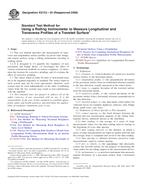We need your consent to use the individual data so that you can see information about your interests, among other things. Click "OK" to give your consent.
ASTM E2133-03(2009)
Standard Test Method for Using a Rolling Inclinometer to Measure Longitudinal and Transverse Profiles of a Traveled Surface
STANDARD published on 1.11.2009
The information about the standard:
Designation standards: ASTM E2133-03(2009)
Note: WITHDRAWN
Publication date standards: 1.11.2009
SKU: NS-44420
The number of pages: 4
Approximate weight : 12 g (0.03 lbs)
Country: American technical standard
Category: Technical standards ASTM
Annotation of standard text ASTM E2133-03(2009) :
Keywords:
profiling device, rolling inclinometer, transverse and longitudinal profiles, Airport pavement, Construction--paving applications, Distance profile measurement, Elevation profile records, Inclinometer, Longitudinal profile, Pavement surfaces, Profiling devices/measurement, Road roughness, Rolling inclinometer, Roughness, Transverse profile, Traveled surface characteristics, ICS Number Code 93.080.20 (Road construction materials)
Additional information
| Significance and Use | ||||||||||||
|
This test method establishes procedures for collecting elevation and distance data of longitudinal and transverse profiles on a traveled surface. Results of this test are used primarily to: Evaluate the roughness of traveled surfaces, using any of several roughness indices shown in Table 1. Equations required for calculations of various indexes are contained in references shown in Table 1. Note 1—When this test is used to evaluate the compliance of a new pavement surface with contract roughness specifications, the timeliness of the test in relation to the date of the surface's installation is of critical importance. Since most Portland cement concrete surfaces will change shape within a few days after installation—due to changes in thermal and moisture gradients which cause curling at joints and cracks and slab edges—for contractor quality control only, it may be desirable to gather profile data within 72 h after pavement installation. Investigate the effect of different construction methods on resulting pavement surface roughness. Investigate the curvature of (1) pavement surfaces due to curling, and (2) deflection of structural members within bridges and other structures. Identify the locations in need of corrective grinding. Measure rut depth using computer simulation in accordance with Test Method E1703/E1703M. |
||||||||||||
| 1. Scope | ||||||||||||
|
1.1 This test method describes the measurement of transverse and longitudinal surface profiles on paved road, bridge, and airport surfaces using a rolling inclinometer traveling at walking speed. 1.2 It is designed to (1) quantify the roughness of new pavements and bridge decks; (2) Investigate the effect of various construction methods on surface roughness; (3) determine the location for corrective grinding; and (4) evaluate the effect of corrective grinding. 1.3 The values stated in either SI units or inch-pound units are to be regarded separately as standard. The values stated in each system may not be exact equivalents; therefore, each system must be used independently of the other. Combining values from the two systems may result in non-conformance with the standard. 1.4 This standard does not purport to address all of the safety concerns, if any, associated with its use. It is the responsibility of the user of this standard to establish appropriate safety and health practices and determine the applicability of regulatory limitations prior to use. |
||||||||||||
| 2. Referenced Documents | ||||||||||||
|
We recommend:
Technical standards updating
Do you want to make sure you use only the valid technical standards?
We can offer you a solution which will provide you a monthly overview concerning the updating of standards which you use.
Would you like to know more? Look at this page.




 Cookies
Cookies
